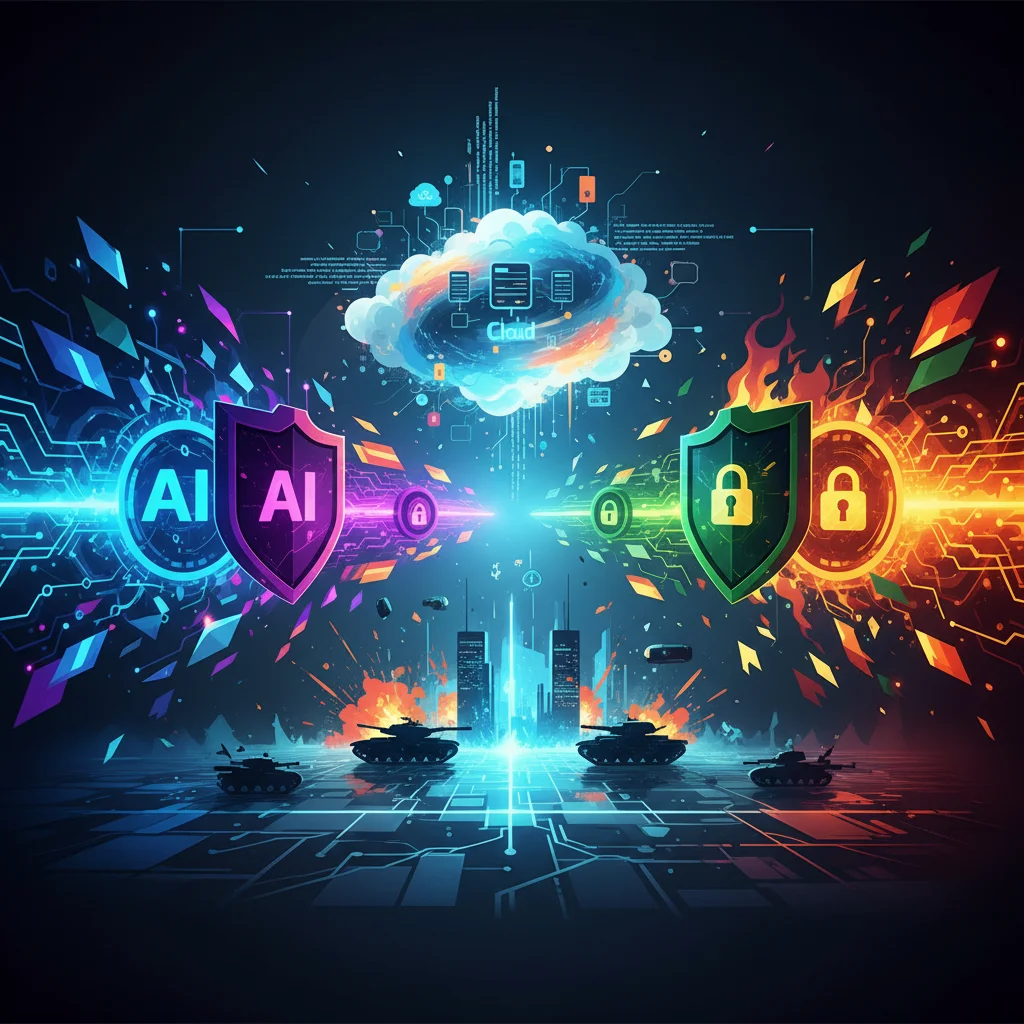
The Code War: How AI, Cloud, and Cybersecurity are Fueling the Next Gaming Battlefield
Every year, like clockwork, the digital world braces for the impact of a new Call of Duty release. It’s more than just a game; it’s a cultural event, a multi-billion dollar software launch that dominates headlines and online conversations. But this year, the familiar rhythm of dominance is accompanied by the thunderous footsteps of a resurgent rival. The annual installment of this massive series faces what many insiders are calling its most significant challenge in years, directly from the camp of its long-time competitor, Battlefield (source).
To the casual observer, this is just another chapter in the age-old console wars. But for developers, tech professionals, and entrepreneurs, this rivalry is a fascinating case study in high-stakes technological warfare. This isn’t a battle fought with virtual M4s and tanks; it’s a conflict waged with proprietary game engines, sophisticated artificial intelligence, massive cloud infrastructure, and cutting-edge cybersecurity. The winner won’t just be the game that’s more “fun”—it will be the one with the superior technology stack, the more resilient platform, and the more innovative business model. Let’s decompile this conflict and analyze the code behind the combat.
The Software Philosophy: Iteration vs. Revolution
At the heart of the Call of Duty vs. Battlefield debate lies a fundamental difference in software development philosophy. Activision’s Call of Duty franchise operates on a relentless, annualized release schedule, powered by a rotating trio of development studios. This model mirrors an aggressive, iterative approach seen in the world of SaaS (Software as a Service), where constant updates and yearly refreshes are the norm. The goal is to maintain market presence, capture annual revenue streams, and continuously refine a proven formula. This rapid pace of development relies heavily on automation in testing and deployment pipelines to hit unforgiving deadlines.
On the other hand, EA’s Battlefield, developed by DICE, has traditionally favored a longer, more deliberate development cycle. This approach allows for more significant technological leaps between installments—what you might call a “revolutionary” rather than “evolutionary” model. Each new Battlefield is often a showcase for the latest version of their powerful Frostbite Engine, promising next-generation destruction physics, graphical fidelity, and larger-scale conflicts. This longer cycle presents its own challenges, requiring immense project management and risking market irrelevance if the final product doesn’t meet sky-high expectations. This strategic divergence sets the stage for a classic business showdown: the agile incumbent versus the disruptive challenger as reported by industry watchers.
Beyond the Hype: Is Elon Musk's Optimus Robot the Future of Everything?
The Technological Arms Race: Engines, AI, and Cloud Infrastructure
Beneath the surface of stunning visuals and explosive gameplay lies a complex web of software and infrastructure that truly defines these gaming titans. This is where the real war is fought.
Proprietary Engines as a Moat
A game engine is the foundational software framework upon which the entire experience is built. It’s the operating system for the game world, handling everything from rendering graphics and calculating physics to processing audio and running AI. Both franchises rely on powerful, in-house engines:
- Call of Duty’s IW Engine: Continuously iterated upon for over a decade, the IW Engine is a masterclass in optimization. Its primary strength is delivering a smooth, high-framerate experience (often targeting 60 or 120 FPS), which is critical for the fast-paced, twitch-based gameplay the series is known for. It’s a testament to expert programming and refinement over many product cycles.
- Battlefield’s Frostbite Engine: Frostbite was built from the ground up to handle massive scale and environmental destruction. It’s the technology that allows entire buildings to crumble in real-time, a key differentiator for the franchise. While incredibly powerful, its complexity has sometimes been a challenge for development teams to wrangle.
The Unseen Influence of Artificial Intelligence
When we talk about AI in gaming, we often think of simple enemy “bots.” But today, artificial intelligence and machine learning are deeply integrated into the core of these platforms in far more subtle and powerful ways:
- Skill-Based Matchmaking (SBMM): Love it or hate it, SBMM is a direct application of machine learning. Algorithms analyze dozens of player metrics in real-time—accuracy, movement, score-per-minute, reaction time—to create lobbies where players are theoretically matched against those of similar skill. The goal is player retention, a key metric for any service-based platform.
- Anti-Cheat Systems: Modern cheat detection is a cybersecurity battleground. Kernel-level drivers and server-side analytics use ML models to identify patterns of behavior that are impossible for humans. The system learns what “normal” play looks like and flags statistical anomalies, from impossibly fast aiming to seeing through walls.
- Player Behavior Analytics: Studios collect immense amounts of telemetry data. Heatmaps showing where players die most often, weapon usage statistics, and player flow through maps are all fed into analytics platforms. This data-driven approach informs game design, patch notes, and future content, effectively using the player base as a massive, continuous QA team.
The Power of the Cloud
The epic, 64-vs-64 player battles that define franchises like Battlefield are only possible because of scalable cloud infrastructure. Modern multiplayer gaming relies on a global network of servers to provide low-latency experiences. This is where the big publishers’ investments in cloud partnerships (with AWS, Azure, or Google Cloud) pay dividends. This infrastructure-as-a-service model allows them to spin up virtual servers based on real-time player demand, ensuring stability during peak launch windows and managing costs during off-hours. It’s a perfect example of applying enterprise-level cloud architecture to consumer entertainment, a challenge many startups in the space are trying to solve for smaller developers.
AI's Dirty Secret: Why Your Company's Biggest Hurdle Isn't the Algorithm
A Comparative Analysis: Tech Stacks and Strategies
To truly understand the competitive landscape, it’s helpful to break down the core technological and business strategies of each franchise. The following table provides a high-level comparison for tech professionals:
| Feature / Strategy | Call of Duty (Activision) | Battlefield (EA / DICE) |
|---|---|---|
| Core Engine Philosophy | Iterative refinement of the IW Engine for performance and speed. | Generational leaps with the Frostbite Engine for scale and destruction. |
| AI & Machine Learning Focus | Player retention (SBMM), behavior analytics, and anti-cheat. | Complex physics simulations, large-scale environmental AI, and advanced vehicle systems. |
| Cloud & Infrastructure | Massive global server footprint optimized for low-latency, small-to-medium scale matches. | High-compute servers designed to handle large player counts and complex physics calculations. |
| Cybersecurity Approach | Aggressive, often kernel-level anti-cheat software (RICOCHET) using ML behavior analysis. | Server-side validation and proprietary anti-cheat (FairFight) focused on statistical analysis. |
| Business Model Innovation | Pioneered the free-to-play “Warzone” model, integrated with annual premium releases and a Battle Pass system. A leading example of Games-as-a-Service (GaaS). | Traditionally premium-focused, now adopting GaaS elements like Battle Passes and live service updates. |
The Future of the Fight: Beyond the Next Release
The ongoing rivalry between these two behemoths is more than just entertainment; it’s a bellwether for the entire tech and software industry. The challenges they face—from mitigating cybersecurity threats to leveraging AI for user engagement and building scalable cloud-native platforms—are the same challenges faced by startups and Fortune 500 companies alike. The fact that the gaming industry is often the first to tackle these problems at a massive consumer scale makes it a crucial field to watch for signs of technological innovation.
The outcome of this “console war” will have ripple effects. A successful Battlefield launch could validate the longer, R&D-heavy development cycle, while another dominant year for Call of Duty would reinforce the power of an iterative, service-based software model. According to market analysis, the stakes have never been higher, with billions in revenue on the line (source).
Ultimately, this battle reminds us that in the digital age, every product is a technology product. The victor will be the one that not only creates a compelling experience but also masters the underlying complexities of modern software development, from elegant programming and intelligent automation to robust infrastructure and vigilant cybersecurity. For tech professionals, the message is clear: the most exciting innovations are happening on the digital battlefield.
The Great AI Power Play: Is Big Tech Forcing the EU to Back Down on Its Landmark AI Act?


